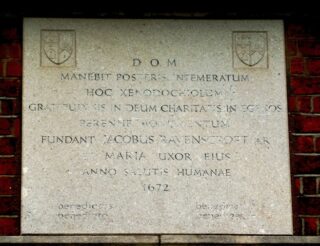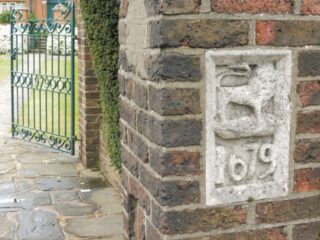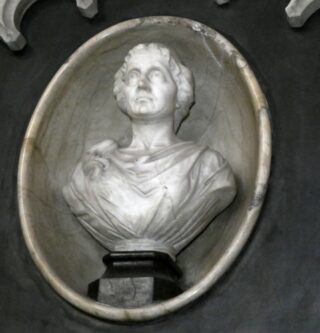Chipping Barnet. Ravenscroft or Jesus Hospital
Colin Wilson
The Sisters of Jesus Hospital were neither nuns nor nurses. They were the residents of James Ravenscroft’s almshouse in Wood Street, Chipping Barnet. Hospital did not carry the same medical connotation as nowadays; it was a place of hospitality or a hospice.
Strictly speaking these almshouses were known as Jesus Hospital. They have been cited as Ravenscroft in this article to concentrate on this building. The Jesus Hospital Charity was involved with other almshouses, which will be elaborated on in a separate article.
James’s will places him in the Middle Temple, Holborn, where he was a lawyer. He was also a merchant. The almshouse proposals began in 1672 and land purchased from Thomas and Martha Massam. The buildings were completed by 1679, with endowments of land in Stepney or Shoreditch (now Bethnal Green). That would explain the 1672 and 1679 dates. There was a legal procedure whereby the trustees and sisters were invested with the almshouses. While he was still in good health (for his age of 84), he knew he would not have much longer to live; James died the following year, in 1680. His tomb is in the Church of St John the Baptist, Chipping Barnet. His wife Mary was also involved in the project.
The almshouses are in the general style of almshouses of the time, but there were many differences in the way they were run. Unlike most others Ravenscroft did not name them after himself, nor did he restrict the sisters to a specific religious affinity, though he was a member of the Church of England. There were six sisters, who would have to be over 50 years of age (quite young compared to other almshouses). The eldest was the governess; she had extra income and the profits from a piece of land at the end of the hospital. The others followed by date of admission. It seems that the sisters had some sort of interest (technical term) in the almshouses as they were involved in the original setup. Cussans notes that a full account is contained in the Harleian Manuscript, No 6379, preserved in the British Museum. The Victoria County History entry reads, ‘The institution was to be a body corporate, and the said James Ravenscroft thereby granted to the governess and sisters the hospital site and buildings erected by him, and adjoining ground, and confirmed to the same corporation a piece of ground in Stepney’. The nine trustees were (and still are) known as Visitors. Two were churchwardens from the parish, two were aldermen from St Albans, and the others were gentlemen, but not from the parish of Barnet. The number and composition has varied over time. This presumably reduced the chances of gaining personal advantage or promoting a political or religious agenda.
This did not stop complaints, of course. James veered towards the anglo-catholic tradition of the Church of England. By about 1715 (only 30 years after the foundation) it was said that most of the Visitors were Dissenters, and the sisters attended Wood Street Meeting House. Hence the complaint was that Church of England people were at a disadvantage. Just remember that most almshouses of the day were restricted to Church of England communicants. They sat on allotted pews the same colour as their dresses. Maybe this indicates they wore a sort of uniform, like the Chelsea pensioners of today. It is known that some other almshouses had such a stipulation. However, for some reason, the meeting house closed for a while. It thus had nothing more to do with the almshouses (though it never had any formal link). An article from 1904 noted that the last two residents to die were Brethren and Wesleyan, and the makeup of the Visitors would have made it very unlikely that all would have attended Wood Street meeting House – at least two were churchwardens. The original
The accounts were published in Barnet Press 11 May 1889. They reveal some interesting points. The sisters received 15s each a week plus two tons of coal and a Christmas gratuity. A nurse was paid 4s a week for 20 weeks, with a further 12s for other medical expenses (this may be for a quarter). Palmer’s and Garrett’s charities received £32 each. Architect’s and restoration costs came to just over £200.
About the start of the 20th century a number of areas tried to consolidate charities under a local council umbrella, and Barnet was no exception. There was a rumour that the Trustees had not maximised the income, though there was no suggestion of irregularity. Also, the Charity was wealthy, and had considerably increased the wealth. It was suggested that amalgamating charities would spread that wealth, in spite of the fact that the charity supported many other local charities as it was. Maybe local authorities always think they can do better.
The space in front of the almshouses was common but boggy. Maybe this was why the building is so far back from the road. Permission was given in the 1880s to enclose the area on condition it was laid out as ornamental gardens. The almshouses are not in totally original condition; they were largely rebuilt in the late 19th century. It will be no surprise that the buildings were grade II listed by Historic England in 1950, ref 1192624.
This is not the end of the story. Since about 1927 the Jesus Hospital Charity has grown and developed through new buildings and amalgamations. That will form the basis of other articles.
Location
62 – 72 Wood Street, Barnet
Georef: 524272 196469
Grid Ref: 51o 39′ 12″N 0o 12′ 19″W
OS 25” map Hertfordshire XLV.3 pub 1898
References
The Historical Antiquities of Hertfordshire, by Sir Henry Chauncy
P279
Kohler & Coombs of Dorking 1700 2nd ed 1826
The History & Antiquities of the County of Hertford by Robert Clutterbuck
p149-50
Printed by and for John Bowyer Nichols, 25 Parliament Street, London 1827
History of Hertfordshire by John Edwin Cussans
Page 57
Originally published Stephen Austin & Sons 1870-81
Republished E P Publishing in collaboration with Hertfordshire County Library 1972
Barnet and Hadley Almshouses, by W H Gelder
Pages 31 – 7
Barnet press group 1979
The Victoria County History of the County of Hertford, ed William Page
Vol 2 p334 – 6
Issued Archibald Constable & Co. 1908. Reprint by Dawsons of Pall Mall 1971 ISBN 0 7129 0476 X)
This publication is available online at http://www.british-history.ac.uk/vch/herts/vol2/pp329-337
See also http://www.british-history.ac.uk/london-environs/vol4/pp1-8
Documents at Archives
HALS
DE/Bz/T50-T68 papers of the Jesus Hospital Estate. Most of these are leases which are better mentioned under the Jesus Hospital Charity.
London Metropolitan Archives Collage. These can be viewed on-line at https://search.lma.gov.uk
31543 View of Ravenscroft’s Almshouses at Chipping Barnet, Hertfordshire; Chipping Barnet is now in the London borough of Barnet, 1795. From Lysons’ Environs of London. Catalogue No k1249842
31455 Inscription on Ravenscrofts Almshouses on Wood Street, Barnet in Hertfordshire c1820. From Wakefield Collection. Catalogue No k1249612
Websites accessed Aug 2022
Charity Commission https://register-of-charities.charitycommission.gov.uk/charity-search/-/charity-details/3957090
Barnet Society https://www.barnetsociety.org.uk
Historic England https://historicengland.org.uk/listing/the-list/list-entry/1192624
Ancestry https://www.ancestry.co.uk/ includes Ravenscroft’s will
Barnet Church https://www.barnetparishchurch.org.uk
Newspapers
See attached document for references and transcripts. These include the ‘discussions’ about Dissenters and the proposed local charity amalgamations. Search under both Ravenscroft and Jesus. They can also be viewed on the British Newspaper Archive website.
Herts Advertiser 16 December 1876 page 8 Jane Thompson died aged 78 year
Barnet Press 24 February 1883 page 4, 5 In the chancel is a monument to Thomas
Ravenscroft, Esq. His family has erected almshouses here, and a hospital for six
poor women
Barnet Press 11 August 1883 page 6 col 5 land in front of almshouses
Barnet Press 05 July 1884 page 7 col 2 Attendance at Wood Street meeting house
Barnet Press 12 February 1887 page 7 col 3 Death of Margaret Wade age 85
Barnet Press 16 April 1887 page 6 col 2. Suggestions for using funds for other purposes
Barnet Press 25 April 1891 page 2 Surplus funds used to support education
Barnet Press 10 April 1897 page 6 col 4 lease at BethnalGreen
Barnet Press 19 March 1904 page 6 col 6 Religious requirements



















Add your comment about this page